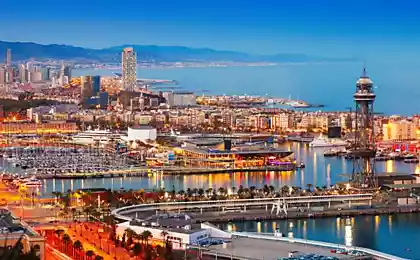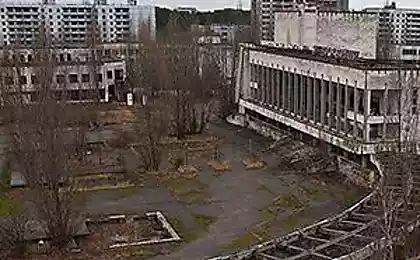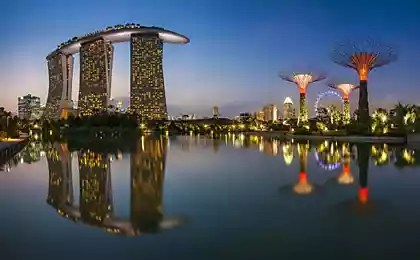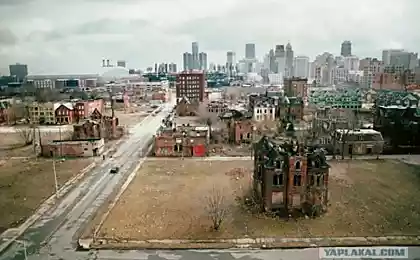1323
Cities

In 2025, more than 60% of the world population, and is expected to 8 billion people will live in cities. Over 90 supermegapolisov will have more than 5 million inhabitants (in 1950 these towns were only 5). In 1980, there were 22 cities with a population of 5 million people, 36 cities with a population of 3 million people, 230 - more than 1 million. Two-thirds of these cities are in developing countries. For comparison - in 1800, only London and Tokyo (then called Edo) were cities. 50 years later, in 1850, lived in London 2 million inhabitants in Paris 1 million. In 1900, in the cities of Berlin, Vienna, Moscow, St. Petersburg, New York, Chicago, Philadelphia, Tokyo and Calcutta home to more than 1 million people (each). In the 16th century the area of Paris was only 8 square miles, now it has grown to 480 square kilometers
Some large cities "grow" so that merge with neighboring, such as West Midlands in the UK and southeastern US city of Boston-New York-Philadelphia-Baltimore-Washington, overgrown in belt length of 1000 kilometers and a population of 40 million inhabitants. In the same way Japan's capital city Tokyo is growing in the direction of Nagoya-Osaka. Such formations are called megacities.
In 1800, only 2.5% of the population lived in cities, in 1920 this figure was 9.2%, in 1980 - 40%. In 2000, more than half of the population lived in cities. This value depends on the level of development of the state, for example, in the UK more than 90% live in urban areas in Latin America is 70 percent.
The largest number of rural people living in Africa, Latin America and Asia, but they are also the fastest growing city.
In Mexico City, the density of population is 7000 people per square kilometer, that is, each person has 140 square meters. This is considering the entire urban area, the area of roads, shops, markets ... The average population density in Mexico while 41 people per square kilometer
In Denmark, for the organization of the city quite 250 people in the United States 2500 people, in Greece 10 thousand people. The UN has set this value at the level of 20 thousand people.
The first large cities began to appear in what is now southern Iraq 3500 BC After 500 years of urban development began to deal with the Egyptians, even after 500 years, the city appeared in India. first Chinese city appeared for 1600 years BC. The Chinese, by the way, built the city in the direction from east to west, thus symbolizing the creation of the universe (I do not know what's the east and west, ...). Among the ancient cities were also one million - is Babylon, Beijing, Rome and Byzantium.
The city began to appear when people began to produce more food than they consume. This allowed some residents to become artisans, merchants, soldiers, monks. They are not produced, and provided services)) became the center of civilization, and their wealth can be seen now on the monumental remains of ancient buildings. Most often, they are based on flat hilltops, crossroads of trade routes, near the mouths of rivers and places with a favorable climate.
Why villagers turn into urban? This, I think, clear to everyone - in the cities above wages, better level of health and social services, education, and more fun.
Rapid urban growth causes congestion, housing problems, difficulties with movement and pollution. "Newly" citizens often forced to live in slums, especially if it occurs in developing countries. In India and Latin America are often visitors have to spend the night under the open sky.
In large cities, increased levels of crime, prostitution and drug addiction. The number of homeless people also increases with the size of the city. This is understandable - in a small town or village housing is usually provided everything is at home even let ...
In developing countries (and in developed as well) there is the concept of satellite cities, which play the role of "safety valve" for the surplus population of the main city. People work in the city, and actually live in the suburbs. In China, for example, to move to the capital requires a special permit.
Contributed to the growth of cities and even traffic boom - develop a network of rail, road and electric. Residents may be relatively easy to move from the city to the suburbs and back. It is believed that this effect is most pronounced in the USA, Canada and Australia, less - in Europe.
The growth of cities has caused another interesting phenomenon - shift of consumer demand in the suburbs. Residents of even relatively wealthy, began to prefer shopping in the suburbs, where property taxes lower and prices, respectively, too. Not by chance in the middle of the big cities you can find trendy empty stores that buy only do visitors.
Los Angeles (LA) with adjoining territories has more than 14 million people. In LA there is no one center of the city - a suburb of the size of a big city. An attempt was made to create a center for this part of the city is built skyscrapers, museums and luxurious hotels. The area became exclusively a business center with no real life of citizens in any way. Still it is possible to say that LA is a big highway. It has 7 and a half of drivers and more than 8 million vehicles. 85% of residents commute to work by car, visiting restaurants that serve food directly into the car, watching a movie out of the car and "exposed" service in the car)) This saturation of transport causes yellowish smog over the city, causing a lot of problems with breathing and vision. Traffic jams are continuously formed throughout the 1,050 kilometers of roads of Los Angeles.
In 1942, Tokyo totaled 6.9 million inhabitants in 1990 - more than 11 million. The population density in some areas of Tokyo reaches 60,000 people per square kilometer - each person has to the square of 4 by 4 meters. Tokyo-Yokohama metropolis inhabited by 19 million people (1985 data). The price of land in Tokyo, the largest in the world - 33 times more than in London, 89 times more expensive than land in New York. Most of the houses are compact and made of wood, and the area per average family of 4 people, does not exceed 65 square meters. Because of this large family in the Japanese capital unpopular.
The high price of land is urban growth (not only in Tokyo) up and into the water. Coast "built up" by using industrial waste, and then turns into a foundation for the new buildings.
That same day in Tokyo over 13000000 people crawling underground. There are even special people - pushers (pushers), who are responsible for "ramming" passengers in the crowded subway cars.
London is interesting because there is no ghetto areas such as Harlem in New York or Watts in Los Angeles.























